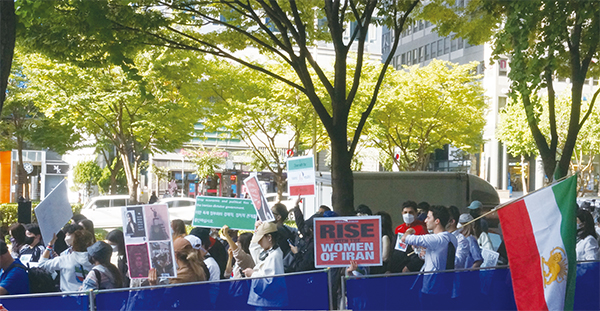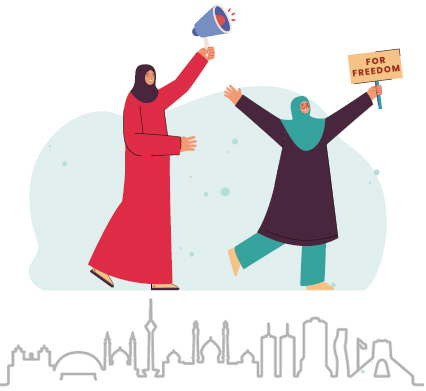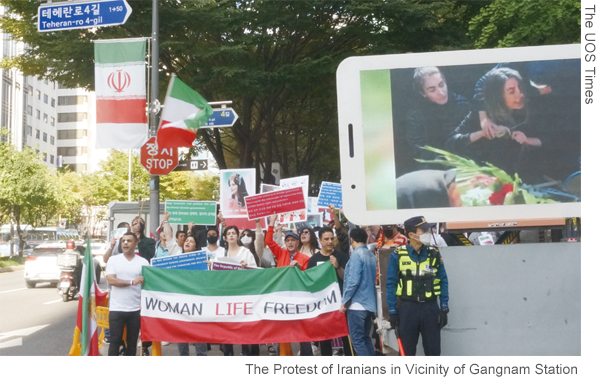Mahsa Amini, a woman in her 20s, died after being taken by the police for not completely covering her hair with a hijab in Iran. She was taken by the police for not covering her head completely with a hijab and was found dead on 16, September. Human rights groups criticized the government of Iran, saying the cause of her death was the assault by the police, but both the government and the police have kept denying it.

Under a law based on Islamic law, the Iranian government forces women to wear a long hijab that completely covers their hair and hides their bodies. The police arrest women who violate the dress regulations although Iranian women have kept expressing opposition. This law was enacted after Islamic Revolution, which occurred in 1979. In 2014, Iranian women publicly posted photos and videos against the hijab law in an online protest campaign called “My Stealthy Freedom.” Its influence later led to movements such as “White Wednesday” and “Girls of Revolution Street”. As such, disputes over women’s rights in Iran have always been around, and people’s anger got even more intense.
The Protest Became a Worldwide Resistance
Mahsa Amini’s death sparked Iranian women’s anger that has accumulated for a long time, and national protests began in many regions of Iran. Though the government tried to appease it as conspiracy trouble, the anger from the public grew more and more. The Iranian protestors have fought for 12 nights in a row.
Over that, some Iranian women have taken off and burnt their hijabs in bonfires. They usually chanted “Zan, Zindagi, Azadi”, which means “woman, life, freedom”. Their anger began to spread all over the world. In Iran’s far southeast area, which is located near Afghanistan and Pakistan, which are also countries that announced Hijab as mandatory, 41 people have been killed during protests blaming a police officer who had raped a teenage girl of the Baluch Sunni minority. Not only in Iran itself, but in 150 cities in the world, there have been clashes between protestors.
Iran’s immature handling has caused even further controversies. The Iranian government has cut off the communication network of people. The police prevented protests by using force against the demonstrators. The number of deaths reported by state broadcasters is 41 (as of 1, October), and local activists say the number is much higher. Supreme leader of Iran, Ali Hossein Khamerei, blamed the fault on a foreign plot. He stated that it is controlled by other nations such as the United States.
This idea comes from massive videos spread through social media and the Internet showing the cruel moment of the Iranian government and police. Also, the videos of a woman cutting their hair short are dispersed like a challenge among celebrities and politicians. The main reformist group inside Iran has required the revocation of the mandatory dress code religiously and the winding down of the morality office, which checks women's appearance: whether they completely cover their hair with a hijab or not. The UOS Times interviewed student A from Iran to get to know their current status in detail.

Q1. Can you explain the current status of Iran and the protests in detail?
A1. The situation in Iran is extremely bad. People are still dying because of police brutality, and the government is trying to cut us off from the world. These protests are caused by Iranians’ anger towards the oppression we face by the government which has been stacked for a few decades. The continued oppression and human rights abuses have exhausted people, and the worsening economic conditions have contributed to triggering protests. I have seen an article interpreting the reason for the protests as simple economic conditions, but it is not that simple. The various problems that have existed in Iran have raised people’s dissatisfaction, and a woman’s death exploded their anger.
Q2. What is living as a woman in Iran like?
A2. It is very difficult. As Islamic-based laws restrict women’s options quite a lot, Women in Iran have lived as helpless beings for many years. We cannot even divorce following our free will. Iran’s current regime is united with religion, which makes religious regulations stronger and women’s rights in Islamic legislation much weaker.
Q3. Do you have anything to say to the world?
A3. We need more attention and help from the world. I hope you pay a little more attention to it. Please do not just think it as the problem of one country far away. Just posting related information on Instagram stories and sharing articles can be helpful enough. It is not a big deal.
The Underlying Revolution Beneath the Violent Clash
In fact, this kind of protests have been held in small or big forms consistently in Iran. However, this clash seems more like a revolution. The outbreak was from a wave of anger due to the violent suppression of the police However, the size of protests is getting bigger and bigger in Iran regardless of the age or sex of the protesters Iran’s trouble goes deeper than religious divides. It is highly related to complicated circumstances in Iran.
A weak financial stance and shortages resulting from the corrupt regime and power abuse which was committed for 43 years are the fundamental reason. The public finally called for Islamic rule to be abolished. The Iranian entrepreneur Mostapa Pazard asserted that women, technology, and the shortage are grounds for this protest. Also, he emphasized that the young generation in Iran is feeling this heavy imprisonment as an obstacle wasting their lives.
The harsh policies of Iranian government over the daily life started after the Islamic Revolution. After the 1981 massacres, Iran faced the largest political massacre in Iranian history, targeting communists, socialists, social democrats, liberals, monarchists, moderate Islamists with the intention of “purifying” Iranian society of non-Islamic elements. This followed more and more totalitarian policies which limited the daily life of Iranians.
With an economy that is getting worse day by day, Iranian people are getting more and more fed up with these totalitarian policies. Iran, having 10 percent of the world's proven oil reserves and 15 percent of its gas reserves, depends heavily on oil and petroleum products for its economy. Iran has been embargoed by the USA and United Nations since 1987 with the reasons such as Iran’s support for terrorism and its uranium enrichment program.
Sanctions have been targeting investments in oil, gas, and petrochemicals, exports of refined petroleum products, and business dealings with the Islamic Revolutionary Guard Corps (IRGC).
In 2016, sanctions from USA and UN were lifted. However, in 2018, President Donald Trump announced that the United States would withdraw from the Iran nuclear deal. Sanctions by the United States were reinstated in November 2018, and expanded in 2019 and 2020 to cover Iran's financial sector.

Over the years, sanctions have taken a serious toll on Iran's economy and people.
Iranian economy experiences a recession. Iran’s inflation rate in July was close to 52.5 percent compared to the previous year. The official unemployment rate is above 10 percent, but the youth unemployment rate is estimated to be above 40 percent. The anti-American government caused an economic crisis and Iranians suffered from it. Furthermore, when the Iran nuclear deal (Comprehensive Joint Plan of Action (JCPOA)), which promised to lift Iran’s economic sanctions, was frustrated, the public’s anger grew even more.
At one time, Iran’s middle class looked at reformist candidates like former President Hassan Rouhani, who led Iran from 2013 to 2021. But Iran’s supreme leader Ali Hossein Khamenei has put the brakes on the reformists, and even hopes for politics have waned. “There is no release valve in Iran,” said Sanam Bakil, deputy director of the Middle East and North Africa at the Royal Institute in the UK.
On top of this matter, their paralyzing fear of the morality police, and the regular and routine humiliations that women suffer are also one of the main reasons for the protests. Given the long period of enduring from these enforcers of the Islamic religious code, there’s more than enough repressed anger to protest among the country’s 40 million women. Since the Islamic regime came to power in 1979, Iranian women, once the best educated segment of the population, have suffered disproportionately under the enforced politicized Islamic rules. This shows the heat which was started by a woman wearing a hijab has grown to melt down the clogged system, the Iranian government.
The Only Way to Save Them
The Iranian people are still fighting for the basic human rights that deserve to be guaranteed. In addition to the problem of human rights abuses, the Iranian government’s inappropriate response is highly criticized internationally. Canadian Prime Minister Justin Trudeau said that he would impose sanctions on the “morality police” and their leadership who are responsible for the death of Mahsa Amini. Germany also summoned the Iranian ambassador to Berlin to urge the Iranian government to stop suppressing protesters and guarantee peaceful demonstrations. Iranians in Korea are also joining the movement. Approximately 20 Iranians gathered near the Embassy of the Islamic Republic of Iran in Seoul on 28, September.
Pastor Park Seema, an Iranian who was naturalized in Korea in the 1990s, said, “It started with the problem of women wearing hijabs, but the ultimate goal of Iranians who have gone on a protest is to change the regime,” adding, “If a woman dies because she showed her hair, the regime is no longer necessary.” She also added, “I’m not telling people not to wear hijab.
However, it’s a problem if the government kills people because of that hijab. How can I live in a country where I cannot freely choose my body and clothes?” in an interview with BBC Korea. Pastor Park expressed expectations that the protests could fundamentally change Iran. There have been large and small protests and revolutions in Iran over the past few decades, but there has not been any protest led by women on a national scale like this.
To save Iranian women’s lives and steer the world toward the right direction for human rights, each person’s attention is essential. The lives of Iranian women which have been suppressed for a long time must finally be free through this opportunity. This issue is worth a lot more hype and attention than now and accordingly, Iranians’ protest is likely to continue until the majority of the world listens to their voice. The UOS Times had a chance to have a brief interview with the leading protester at the Solidarity Protest in the vicinity of Gangnam Station. When questioned about how long the protest will last, she replied “Until when the lives of the Iranians get better.”
Lee Seung-bum okok3037@uos.ac.kr
Sa Mok-hui smklsj0727@uos.ac.kr

